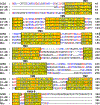Negative allosteric modulators of cannabinoid receptor 2: protein modeling, binding site identification and molecular dynamics simulations in the presence of an orthosteric agonist
- PMID: 30652534
- PMCID: PMC7487276
- DOI: 10.1080/07391102.2019.1567384
Negative allosteric modulators of cannabinoid receptor 2: protein modeling, binding site identification and molecular dynamics simulations in the presence of an orthosteric agonist
Abstract
Selective activation of the cannabinoid receptor subtype 2 (CB2) shows promise for treating pain, inflammation, multiple sclerosis, cancer, ischemic/reperfusion injury and osteoporosis. Target selectivity and off-target side effects are two major limiting factors for orthosteric ligands, and therefore, the search for allosteric modulators (AMs) is a widely used drug discovery approach. To date, only a limited number of negative CB2 AMs have been identified, possessing only micromolar activity at best, and the CB2 receptor's allosteric site(s) are not well characterized. Herein, we used computational approaches including receptor modeling, site mapping, docking, molecular dynamics (MD) simulations and binding free energy calculations to predict, characterize and validate allosteric sites within the complex of the CB2 receptor with bound orthosteric agonist CP55,940. After docking of known negative CB2 allosteric modulators (NAMs), dihydro-gambogic acid (DHGA) and trans-β-caryophyllene (TBC) (note that TBC also shows agonist activity), at the predicted allosteric sites, the best total complex with CB2, CP55,940 and NAM was embedded into a hydrated lipid bilayer and subjected to a 200 ns MD simulation. The presence of an AM affected the CB2-CP55,940 complex, altering the relative positioning of the toggle switch residues and promoting a strong π-π interaction between Phe1173.36 and Trp2586.48. Binding of either TBC or DHGA to a putative allosteric pocket directly adjacent to the orthosteric ligand reduced the binding free energy of CP55,940, which is consistent with the expected effect of a negative AM. The identified allosteric sites present immense scope for the discovery of novel classes of CB2 AMs.
Keywords: CB2 allosteric modulator; CB2 receptor; G-protein-coupled receptor; docking; molecular dynamics.
Figures















Similar articles
-
In Silico Prediction and Validation of CB2 Allosteric Binding Sites to Aid the Design of Allosteric Modulators.Molecules. 2022 Jan 11;27(2):453. doi: 10.3390/molecules27020453. Molecules. 2022. PMID: 35056767 Free PMC article.
-
Allosteric and orthosteric pharmacology of cannabidiol and cannabidiol-dimethylheptyl at the type 1 and type 2 cannabinoid receptors.Br J Pharmacol. 2019 May;176(10):1455-1469. doi: 10.1111/bph.14440. Epub 2018 Aug 10. Br J Pharmacol. 2019. PMID: 29981240 Free PMC article.
-
Design of Negative and Positive Allosteric Modulators of the Cannabinoid CB2 Receptor Derived from the Natural Product Cannabidiol.J Med Chem. 2021 Jul 8;64(13):9354-9364. doi: 10.1021/acs.jmedchem.1c00561. Epub 2021 Jun 23. J Med Chem. 2021. PMID: 34161090
-
Allosteric modulators targeting cannabinoid cb1 and cb2 receptors: implications for drug discovery.Future Med Chem. 2019 Aug;11(15):2019-2037. doi: 10.4155/fmc-2019-0005. Future Med Chem. 2019. PMID: 31517528 Review.
-
Translational potential of allosteric modulators targeting the cannabinoid CB1 receptor.Acta Pharmacol Sin. 2019 Mar;40(3):324-335. doi: 10.1038/s41401-018-0164-x. Epub 2018 Oct 17. Acta Pharmacol Sin. 2019. PMID: 30333554 Free PMC article. Review.
Cited by
-
Novel approaches and current challenges with targeting the endocannabinoid system.Expert Opin Drug Discov. 2020 Aug;15(8):917-930. doi: 10.1080/17460441.2020.1752178. Epub 2020 Apr 27. Expert Opin Drug Discov. 2020. PMID: 32336154 Free PMC article. Review.
-
In Silico Prediction and Validation of CB2 Allosteric Binding Sites to Aid the Design of Allosteric Modulators.Molecules. 2022 Jan 11;27(2):453. doi: 10.3390/molecules27020453. Molecules. 2022. PMID: 35056767 Free PMC article.
-
A Guide to Targeting the Endocannabinoid System in Drug Design.Int J Mol Sci. 2020 Apr 16;21(8):2778. doi: 10.3390/ijms21082778. Int J Mol Sci. 2020. PMID: 32316328 Free PMC article. Review.
-
Targeting the endocannabinoid system: Structural determinants and molecular mechanism of allosteric modulation.Drug Discov Today. 2023 Jul;28(7):103615. doi: 10.1016/j.drudis.2023.103615. Epub 2023 May 11. Drug Discov Today. 2023. PMID: 37172889 Free PMC article. Review.
-
Analgesic Potential of Terpenes Derived from Cannabis sativa.Pharmacol Rev. 2021 Oct;73(4):98-126. doi: 10.1124/pharmrev.120.000046. Pharmacol Rev. 2021. PMID: 34663685 Free PMC article. Review.
References
-
- Abood ME (2016). Allosteric Modulators: A Side Door. J Med Chem, 59(1), pp. 42–43. doi:10.1021/acs.jmedchem.5b01824 Retrieved from 10.1021/acs.jmedchem.5b01824https://www.ncbi.nlm.nih.gov/pubmed/26645411 Retrieved from https://www.ncbi.nlm.nih.gov/pubmed/26645411 - DOI - PubMed
-
- Alaverdashvili M, & Laprairie RB (2018). The future of type 1 cannabinoid receptor allosteric ligands. [Review]. Drug Metabolism Reviews, 50(1), pp. 14–25. doi:10.1080/03602532.2018.1428341 Retrieved from 10.1080/03602532.2018.1428341https://www.scopus.com/inward/record.uri?eid=2-s2.0-85043599300&doi=10.1... Retrieved from https://www.scopus.com/inward/record.uri?eid=2-s2.0-85043599300&doi=... - DOI - PubMed
-
- Alqarni M, Myint KZ, Tong Q, Yang P, Bartlow P, Wang L, … Xie XQ (2014). Examining the critical roles of human CB2 receptor residues Valine 3.32 (113) and Leucine 5.41 (192) in ligand recognition and downstream signaling activities. Biochem Biophys Res Commun, 452(3), pp. 334–339. doi:10.1016/j.bbrc.2014.08.048 Retrieved from 10.1016/j.bbrc.2014.08.048http://www.ncbi.nlm.nih.gov/pubmed/25148941 Retrieved from http://www.ncbi.nlm.nih.gov/pubmed/25148941 - DOI - PMC - PubMed
-
- Bernardes WA, Lucarini R, Tozatti MG, Flauzino LG, Souza MG, Turatti IC, … Cunha WR (2010). Antibacterial activity of the essential oil from Rosmarinus officinalis and its major components against oral pathogens. Z Naturforsch C, 65(9–10), pp. 588–593. Retrieved from http://www.ncbi.nlm.nih.gov/pubmed/21138060 - PubMed
-
- Cascao R, Vidal B, Raquel H, Neves-Costa A, Figueiredo N, Gupta V, … Moita LF (2014). Potent anti-inflammatory and antiproliferative effects of gambogic acid in a rat model of antigen-induced arthritis. Mediators Inflamm, 2014, p 195327. doi:10.1155/2014/195327 Retrieved from 10.1155/2014/195327http://www.ncbi.nlm.nih.gov/pubmed/24623960 Retrieved from http://www.ncbi.nlm.nih.gov/pubmed/24623960 - DOI - PMC - PubMed
Publication types
MeSH terms
Substances
Grants and funding
LinkOut - more resources
Full Text Sources
Other Literature Sources
Research Materials
Miscellaneous
